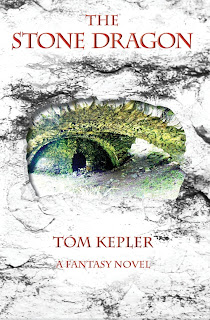I've decided to publish three short stories as an e-book to sell for $.99, which comes to about 125 words per penny.
The cover above is in its current incarnation. I took the original photo and used a section to save as background color with texture--just plain color wasn't dynamic enough. Then I added that twice as a background layer, top and bottom of the image. I added the eye section of the original photo to the middle. Then I used the feather gradient to blend everything. I added the text, originally a red, but I felt the white showed up more and also provided more unity because of the white of the eye. Finally, I rotated the eye to give more dynamism to the image. With the text, I played around with bevel/emboss, stroke, and character height to add more presence to the text. Then I removed the bevel/emboss because the letters didn't stand out so much in a small thumbnail size image (what most online cover images will be). There are probably more things I could do, but I had a lot of fun. I'm really getting the hang of layers in PhotoShop. It allows for a lot of experimentation without messing up what works.
The one below was my first try. I just didn't feel good about it. Not as much dynamism--in my opinion, anyway.
- "Who Listened to Dragons," 9,500 words.
- "River's Daughter," 2,500 words
- "T 'Uk's Dilemma," 1,200 words
All three short stories are set in the Dragons of Blood and Stone series reality, the setting of The Stone Dragon. I also found an image that I think will be great for the SD sequel, Dragons of Blood and Stone. I hope to start working on that by spring at the latest.
Right now I have the e-book uploaded to my Kindle, and I'm going through it for a last time, looking for little errors and formatting issues. I wrote about this process in my blog post "Kindle as a Writing Tool."
 Adding photos makes the process a little more tricky, especially when uploading to different sites (Kindle and Smashwords). Sometimes you just have to say, "This is as good as it's going to get with the current technology."
Adding photos makes the process a little more tricky, especially when uploading to different sites (Kindle and Smashwords). Sometimes you just have to say, "This is as good as it's going to get with the current technology."I plan to publish the books on my birthday, this Thursday, February 2. If I can feel comfortable with the e-formats, then publishing the stories will be my birthday present to myself. At this point, I think I probably won't make that birthday goal. I don't want to lower the quality of the product for an artificial deadline.
I've also been enjoying making covers for the stories. The three stories will be published under Who Listened to Dragons, but I made covers for each story to front the short story in the e-book.
I like the Dragons of Blood and Stone image. It connects with the cover image on The Stone Dragon. This was a quick version of the cover. I think I can make it better with more time, but having the cover is a real inspiration to start Draft 2 of the novel!
I'm also playing around and making banners for advertising. Here's one I've made for the e-book. It's smaller because of the size required for the half-banner advertisement. I'll change it to use the new "blue" image, but I was practicing using a sideways (horizontal) format.
These will be the first publications that I've used online stock photos for. That is a fun experience, looking through huge catalogs of images to find one to use. The price is really inexpensive, too.
Copyright 2012 by Thomas L. Kepler, all rights reserved


























